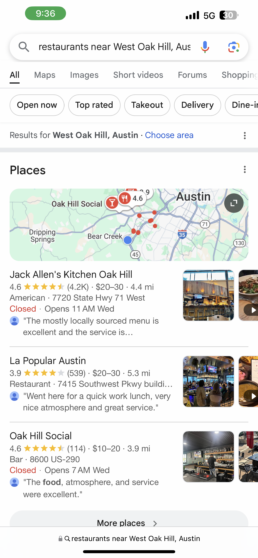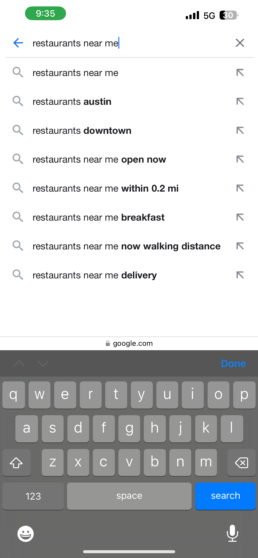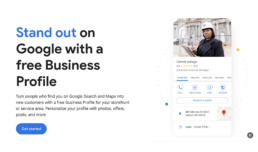Too much of what we call marketing is ‘top-of-funnel’ which essentially means, we’re letting people know that we exist. Our audience for these ‘top-of-funnel’ ads aren’t thinking about eating at a restaurant, but if we run these broad ads to a wide selection of people, when they do, they * might * think of us.
As a marketer I guess I’m supposed to say that billboards, radio and broad keyword PPC (pay per click advertising) are worth it.
But I don’t actually buy it. Literally. I don’t spend money on broadly-targeted, super-expensive media buys. I can’t see the ROI.
If you’re looking to stretch your marketing dollars and maximize ROI, then you want to be looking at local search, specifically ‘near me’ searches done by people on mobile phones.
Why?
Local searchers mean business
Because the people doing these searches mean business. I’m serious. These are people that want to do business, and they’re ready to do business within the hour.
Now that is an audience worth targeting, amiright?
‘Near me’ searches on Google have risen over 900% in the last few years as mobile phone users get savvy and understand that Google knows where they are, and knows how to direct them to what they’re looking for.
That’s why they are doing a local search, after all – they are trying to find something. And not just that, they are trying to find something with the intent to make a purchase.
The stats are impressive.
76% of people who perform a ‘near me’ local search visit a store within 5 miles of their location within 24 hours. In fact, people do ‘near me’ searches while they are actively shopping. According to seoprofy.com, 82% of U.S. shoppers use “near me” searches on their smartphones while shopping.
900%
Growth in 'near me' searches
76%
of 'near me' searches that lead to a purchase within 24 hours
88%
of local searches that lead to a call or visit within 24 hours
Local search is the jam for local businesses with brick-and-mortar locations. 76% of searchers on a mobile phone visit a business within a day – https://www.onthemap.com/blog/local-seo-stats/
88% of local searches on a mobile device result in a call or visit within 24 hours. In an era of overnight shipping and endless distraction, the fact that there’s such a high degree of follow-through in local searches shows just how high someone’s search intent is when they hit Google for a local search.
28% of local searchers end up making a purchase within 24 hours, according to synup.


‘Near me’ searches are 30% of mobile queries. Think about that for a second. Of all the searches done on mobile phones, 1 in 3 is a ‘near me’ local search with high buyer intent and a greater than 70% chance of a purchase within the next week.
Local search is one of the most efficient ways of marketing your restaurant
If you’re a restaurant owner and you’re looking to improve your business, you can’t do better than trying to reach a ‘near me’ search audience. No other form of marketing even comes close – not social media, not table tents, radio, billboards or any of it.
But local search is a tough game. The reality is that you’re not fighting to be on the ‘first page’ of Google results (although that means less than it used to with sponsored results (ads) filling up the first 3-4 spots). You’re fighting to be on Google Map’s ‘3-pack’ (see above screenshot).
Google Map’s 3-pack is highly competitive, zero-sum real estate. In fact, Google has said there are over 100 different factors that contribute to a local search ranking.
The reality is that Google weighs some items more than others. And for DIY restaurateurs and owners, there’s a straightforward formula you can follow to help you show up in ‘near me’ Google searches – and it all centers around a Google Business Profile (GBP).
Your Google Business Profile is your gateway to ranking higher for ‘near me’ searches
A Google Business Profile is a free service offered by Google. It allows you to control the presentation (but not placement) of your business on Google’s search results, and you can do some reputation management in areas like uploading photos, crafting your service or offering and responding to reviews.
With that in mind, here’s how you can improve your chances of showing up in ‘near me’ local searches.
- Claim your Google Business Profile
- Check the accuracy of restaurant information (hours, address, menus) across online listings, especially between your website and your GBP
- Upload new photos to your GBP
- Encourage customers to leave reviews on Google (but don’t pay or reward reviews, that’s against Google’s Terms of Service)
- Have enough operational excellence to get 4.5 star plus reviews
- Respond to every review, good or bad

Easy-peasy, right? Hardly. A few bullets, but the work of a decade, especially when it comes to gathering reviews.
Google likes recent, high-quality reviews – and Google likes to see activity on the profile, like monthly uploads of images, and review responses.
So let’s dive in to each with the goal of performing better for ‘near me’ searches:
How to claim your Google Business Profile
Google has a helpful article on how to claim your Google Business Profile, here’s a brief overview doing this from a computer:
- From a computer, sign in to Google Maps.
- There are 3 ways to add your business:
- Enter the business address in the search bar. On the left, in the Business Profile, click Add your business.
- Right-click anywhere on the map. Then, click Add your business.
- In the top left, click the ‘menu’ icon (2 lines) and click Add your business.
- Follow the instructions to complete the process of signing up for your Business Profile.
- From a computer, open Google Maps.
- Enter the business name in the search bar
- Click the business name and choose the correct one.
- Click Claim this business > Manage now.
- Need to choose a different business? Click I own or manage another business.
- Select a verification option, and follow the steps.
If the Google Business Profile already exists, you can check out this tutorial on how to request permission to become the owner.
How to check the accuracy of restaurant information on the web
Google likes seeing that your restaurant has consistent information across the web.
That means that your restaurant’s
- Address
- Hours
- Menu
are consistent no matter the platform. Here’s a list of common platforms to help you get started
I recommend putting your current information into a spreadsheet, and have an employee visit each of the above websites to validate the spreadsheet information against the website. If they find an inconsistency, they can make a note so you can go and update it.
How to upload photos to your GBP
- Sign in to your Google Business Profile
- Select the location to manage
- Click Photos (left-side menu)
- Click Add photo
- Choose the photo type
- Select the photos to upload from your device
- Format: JPG or PNG
- Size: Between 10 KB and 5 MB
- Resolution: Recommended 720 px tall, 720 px wide
- Quality: In focus, well lit, and not blurry or pixelated
- Content: Relevant to your business and not offensive or inappropriate
For more information, reference this handy Google Business Profile photo management tutorial from Google.
Do this monthly to show Google that you’re engaged with their platform.
How to encourage customers to leave reviews on Google
Getting more reviews starts to get into the realm of operational execution. It’s such a big deal, I would think about making it a project that your entire business (all your employees) know about, that last for months – essentially you want to move to a culture of politely requesting reviews from customers when appropriate.
Here are some ideas for getting customers to leave more reviews on Google.
- Have employees ask satisfied customers to leave a review after they’ve paid the bill
- You can have a table tent with a QR code that links to your restaurant’s Google Business Profile / reviews page
- Have a QR code that is part of the receipt
- Send emails to customers with requests to leave a review
- If you have to-go bags, add a sticker with a QR code requesting a review
How to create an operation that consistently earns 4.5+ star reviews
This is an entire article! And honestly, I love that marketing ultimately touches the operational core of the business, the customer experience and the messaging around those things.
Here’s a few ideas for how to create operational consistency that translates into consistent 4.5+ star reviews.
- Get serious about measuring the time from order to delivery of food.
- Look for bottlenecks in the process
- Correlate the number of guests with the speed of delivery
- Create excellent training programs – standard operating procedures are a big way to create consistency in service
- Be involved! An owner’s engagement on the floor and in the kitchen, especially during peak times, can signal to your employees that you take this seriously
- Take guest issues seriously – do what it takes to make it right (if possible)
- Spicy take: get rid of your lowest-performing dishes
- They aren’t making you profit
- They create complexity of inventory
- They create an addition burden of training and knowledge complexity
- Stale inventory plus less practice making the dish = higher probability of lower reviews
That’s a non-exhaustive, completely superficial look at creating operational efficiency.
How to respond to every review
If you’re doing a good job getting reviews on Google, Facebook and other places, you’ll probably start to notice that ‘reputation management’ becomes if not a full-time job, then at least one that requires daily vigilance. There are programs out there to help monitor reviews platforms. One I’ve heard about (but haven’t used myself) is a review monitoring platform called Marqii.
Some platforms allow you to set alerts when new reviews come in.
As a business owner, Google allows you to set up alerts to notify you when a new review is posted on Google Maps.
Yelp also allows business owners to configure review alerts.
A couple of things to think about with responding to reviews.
- Keep it professional
- Keep the attention on the customer’s experience
- Customers point out flaws (mostly) to highlight a disappointing experience
- If you can speak to the disappointment, and have a quick suggestion to make it right, you’ll be doing great
- Respond to positive reviews!
- If someone compliments you in the restaurant, you wouldn’t stay silent – you would respond with a hearty ‘thank you’
- Say you are sorry
- Leave any gifts or gift certificates at the restaurant to encourage customers to return
- A positive exchange after a bad dining experience can do wonders for your brand and reputation
- It shows you care deeply about the customers and their experience
- It shows that there’s a person behind the business
- It’s relatable
- Humility and kindness go a long way
To conclude: performing well in ‘near me’ and local searches isn’t rocket science, but it also isn’t easy
‘Near me’ is extremely valuable search real estate – these are customers who want to make a purchase within an hour, a day, a week.
And indeed, none of the suggestions above are technical or esoteric ‘SEO’ tricks. Most of these measure a restaurant with excellent service across its entire guest-facing surface area.
The closest to technical advice / non-obvious strategies is updating photos on your Google Business Profile.
You’ll hear me say this often: a restaurant’s core guest experience, uniqueness and quality naturally radiates out. Marketing is just a way of amplifying (the already great) signal coming from the existing business.
About the author

Jon Simmons
Jon is an Austin-TX based visual branding and marketing specialist. He specializes in local discovery for home & professional services.
Jon has over 15 years of experience driving ROI for small businesses in the form of awareness, calls, emails, downloads of menus and (most importantly) customer visits.
Jon is also a co-owner of Slow North along with his wife (and company CEO) Michelle Simmons. At Slow North, Jon led an SEO campaign to realize a 650% sustained rise in organic search and local search traffic.





